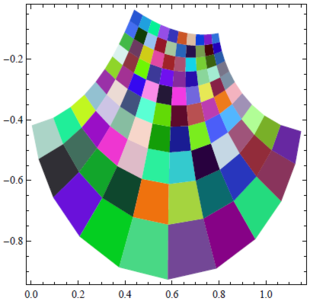14-240/Tutorial-October28: Difference between revisions
No edit summary |
|||
| (7 intermediate revisions by the same user not shown) | |||
| Line 3: | Line 3: | ||
==Boris== |
==Boris== |
||
==== |
====Be Efficient==== |
||
By this point in the course, we become good at solving systems of linear equations. However, we should not use this same |
By this point in the course, we become good at solving systems of linear equations. However, we should not use this same old problem-solving strategy over and over if a more efficient one exists. Consider the following problems: |
||
old problem-solving strategy over and over if a more efficient one exists. Consider the following problems: |
|||
| Line 20: | Line 18: | ||
Yet there is a less time-consuming approach that relies on two observations: |
Yet there is a less time-consuming approach that relies on two observations: |
||
| ⚫ | |||
| ⚫ | |||
| ⚫ | |||
| ⚫ | |||
Since a basis is a generating set and the size of <math>S</math> is <math>4</math>, then the Replacement Theorem tells us that |
Since a basis is a generating set and the size of <math>S</math> is <math>4</math>, then the Replacement Theorem tells us that |
||
<math>S</math> cannot be linearly |
<math>S</math> cannot be linearly independent. Hence, the problem can be solved without solving any linear equations. |
||
independent. Hence, the problem can be solved without solving any linear equations. |
|||
| Line 34: | Line 27: | ||
'''Q2''': Determine if the polynomials <math>x^3 - 2x ^2 + 1, 4x^2-x+3, 3x-2 </math> generate <math>P_3(R)</math>. |
'''Q2''': Determine if the polynomials <math>x^3 - 2x ^2 + 1, 4x^2-x+3, 3x-2 </math> generate <math>P_3(R)</math>. |
||
Once again, we can solve a |
Once again, we can solve a linear equation but we do not have to. Observe: |
||
| ⚫ | |||
| ⚫ | |||
| ⚫ | |||
| ⚫ | |||
| ⚫ | |||
| ⚫ | |||
more efficient strategy to solve a problem. |
|||
====Extending a Linearly Independent Set to a Basis==== |
====Extending a Linearly Independent Set to a Basis==== |
||
'''Boris's tip (for concrete sets and vector spaces only)''': |
|||
'''Consider the following strategy only if you are working with concrete sets and vector spaces:''' |
|||
| ⚫ | |||
| ⚫ | |||
| ⚫ | |||
| ⚫ | |||
vectors from <math>\{(1, 0, 0), (0, 1, 0), (0, 0, 1)\}</math> without disturbing the linear independence of the set. The only |
|||
| ⚫ | |||
question is which vectors should we add? |
|||
| ⚫ | |||
We see that both vectors in <math>S</math> have a <math>0</math> as the third component so a safe choice is to add <math>(0, 0, 1)</math>. Since <math>R^3</math> has a |
|||
dimension of <math>3</math>, then <math>\{(-3, -6, 0), (0, 7, 0), (0, 0, 1)\}</math> is a basis of <math>R^3</math>. |
We see that both vectors in <math>S</math> have a <math>0</math> as the third component so a safe choice is to add <math>(0, 0, 1)</math>. Since <math>R^3</math> has a dimension of <math>3</math>, then <math>\{(-3, -6, 0), (0, 7, 0), (0, 0, 1)\}</math> is a basis of <math>R^3</math>. |
||
==Nikita== |
==Nikita== |
||
Latest revision as of 10:37, 29 November 2014
| |||||||||||||||||||||||||||||||||||||||||||||||||||||||||
Boris
Be Efficient
By this point in the course, we become good at solving systems of linear equations. However, we should not use this same old problem-solving strategy over and over if a more efficient one exists. Consider the following problems:
Q1: Determine if is linearly independent in .
We can solve this linear equation to find the answer:
- where .
Yet there is a less time-consuming approach that relies on two observations:
- (1) The dimension of is so the size of a basis is also .
- (2) No linearly independent set can have more vectors than a generating set (by the Replacement Theorem).
Since a basis is a generating set and the size of is , then the Replacement Theorem tells us that cannot be linearly independent. Hence, the problem can be solved without solving any linear equations.
Q2: Determine if the polynomials generate .
Once again, we can solve a linear equation but we do not have to. Observe:
- (1) The dimension is so the size of a basis is also .
- (2) No generating set can have fewer vectors than a basis (by a Corollary to the Replacement Theorem).
Since there are only polynomials, then the Corollary tells us that it cannot generate . Once again, we used a more efficient strategy.
Extending a Linearly Independent Set to a Basis
Boris's tip (for concrete sets and vector spaces only):
If a problem requires us to extend a linearly independent set to a basis, then the easiest approach is to add vectors from the
standard ordered basis. Here is an example:
Let be a linearly independent subset of . To extend to a basis, add vectors from . The only question is which vector(s) should we add?
We see that both vectors in have a as the third component so a safe choice is to add . Since has a dimension of , then is a basis of .















